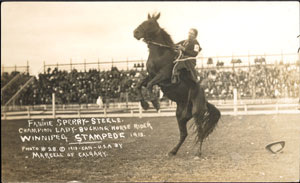
Rodeo is a competitive equestrian sport that arose out of the working practices of cattle herding in Spain and Mexico, expanding throughout the Americas and to other nations. Originally based on the skills required of the working vaqueros and later, cowboys, in what today is the western United States, western Canada, and northern Mexico. Today, it is a sporting event that involves horses and other livestock, designed to test the skill and speed of the cowboys and cowgirls. American-style professional rodeos generally comprise the following events: tie-down roping, team roping, steer wrestling, saddle bronc riding, bareback bronc riding, bull riding and barrel racing. The events are divided into two basic categories: the rough stock events and the timed events. Depending on sanctioning organization and region, other events such as breakaway roping, goat tying, and pole bending may also be a part of some rodeos. According to Encyclopedia Britannica, the "world's first public cowboy contest" was held on July 4, 1883 in Pecos, Texas, between cattle driver Trav Windham and roper Morg Livingston.

Bronc riding, either bareback bronc or saddle bronc competition, is a rodeo event that involves a rodeo participant riding a bucking horse that attempts to throw or buck off the rider. Originally based on the necessary buck breaking skills of a working cowboy, the event is now a highly stylized competition that utilizes horses that often are specially bred for strength, agility, and bucking ability. It is recognized by the Professional Rodeo Cowboys Association (PRCA) and the International Professional Rodeo Association (IPRA).

Barrel racing is a rodeo event in which a horse and rider attempt to run a cloverleaf pattern around preset barrels in the fastest time. Though both sexes compete at amateur and youth levels, in collegiate and professional ranks, it is usually a women's event. It requires a combination of the horse's athletic ability and the horsemanship skills of a rider in order to safely and successfully maneuver the horse around three barrels placed in a triangle pattern within a large arena.

Breakaway roping is a variation of calf roping where a calf is roped, but not thrown and tied. It is a rodeo event that features a calf and one mounted rider. The calves are moved one at a time through narrow runs leading to a chute with spring-loaded doors. The horse and rider wait in a box next to the chute that has a spring-loaded rope, known as the barrier, stretched in front. A light rope is fastened from the chute to the calf's neck, releasing once the calf is well away from the chute and releasing the barrier, which is used to ensure that the calf gets a head start. Once the barrier has released, the horse runs out of the box while the roper attempts to throw a lasso around the neck of the calf.

The Women's Professional Rodeo Association (WPRA) is one of the largest rodeo sanctioning bodies in the world and is open exclusively to women eighteen years of age and older. Headquartered in Colorado Springs, Colorado, the Association currently has over 3,000 members from all over the contiguous United States, Canada, and Australia.

The National Finals Rodeo (NFR) is the premier rodeo competition by the Professional Rodeo Cowboys Association (PRCA). The NFR showcases the talents of the PRCA's top 15 money-winners in the season for each event.
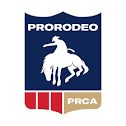
The Professional Rodeo Cowboys Association (PRCA) is the largest rodeo organization in the world. It sanctions events in the United States, Canada, Mexico and Brazil, with members from said countries, as well as others. Its championship event is the National Finals Rodeo (NFR). The PRCA is headquartered in Colorado Springs, Colorado, United States.
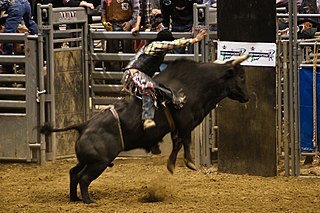
The ProRodeo Hall of Fame and Museum of the American Cowboy was opened in August 1979 as a museum designed to "preserve the legacy of the cowboy contests, the heritage and culture of those original competitions, and the champions of the past, present and future." It is located in Colorado Springs, Colorado, and only inducts Professional Rodeo Cowboys Association and Women's Professional Rodeo Association members. It is the "only museum in the world devoted exclusively to the sport of professional rodeo."
Jan Youren is a retired rodeo competitor. She rode bareback horses and bulls, competing for 51 years and winning many world titles. She rodeoed until the age of 63, when she retired with 5 world championships in bareback bronc riding, 13 reserve championships in bareback, and 15 reserve championships in bull riding. She was inducted into the Cowgirl Hall of Fame in 1993. She was inducted into the Idaho Rodeo Hall of Fame in 2015.
History of tracks the lineage of modern Western rodeo.
The Heart of the North Rodeo is located in Spooner, Wisconsin. The Rodeo takes place the first full weekend in July every year since 1954, except 2020. Spooner Rodeo fans will always see a different act every night, as each rodeo is never the same. Fans from all over come to watch the professional cowboys and cowgirls compete in the 7 main events of rodeo, and even some up and coming little cowboys and cowgirls.
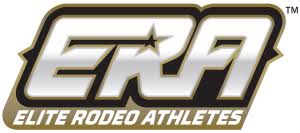
The Elite Rodeo Athletes, also known as the Elite Rodeo Association (ERA), was a professional rodeo organization founded in 2015. Its only competitive season was in 2016, and ceased operations the following year.
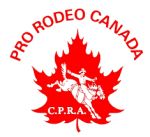
The Canadian Professional Rodeo Association (CPRA) is the governing body of professional rodeo in Canada. Its championship event is the Canadian Finals Rodeo (CFR) held every November. The CPRA also tracks its champions in the List of Canadian Rodeo Champions and its hall of fame inductees in the List of Canadian Pro Rodeo Hall of Fame Inductees.
Mary Burger is an American professional rodeo cowgirl who specializes in barrel racing. She has won two Women’s Professional Rodeo Association (WPRA) barrel racing world championships in 2006 and 2016. Burger was 68 years old when she won the championship in 2016, setting a new record for oldest professional rodeo world champion in any rodeo event, male or female. She broke the existing record set by Ike Rude of 59 years old in steer roping set back in 1953. She also broke the record set by Mary Walker in 2012 at 53 years old. Also In 2016, she became the third WPRA barrel racer to wear the No. 1 back number at the National Finals Rodeo (NFR). She set a new record for season earnings, and she set a new record by becoming the oldest WPRA qualifier to the NFR at 68 years old. Her horses, Mo and Fred, whom she used to win her titles with, she trained in barrel racing herself. In 2017, she was inducted into the National Cowgirl Museum and Hall of Fame.
Mary Walker, is a world champion barrel racer. She won the World Barrel Racing Championship in 2012. Despite several traumatic events in the two preceding years, she persevered. She also became the oldest woman, at 53, in rodeo to win a world championship in the barrel racing event at the National Finals Rodeo. She was later surpassed by Mary Burger in 2016 when Burger won at age 68. She lost her only child to a car accident in 2011. Two months later, Latte, her horse, fell on her during competition and severely injured her. It was about a year and a half after these incidents that she won her world title. Walker was inducted into the National Cowgirl Museum and Hall of Fame in 2013.

Wanda Harper Bush was an American barrel racer who was inducted into the National Cowgirl Museum and Hall of Fame in 1978 and the ProRodeo Hall of Fame in 2017. The August 2017 induction ceremony was ProRodeo's 38th annual event, and marked the first time in the event's history that the class of inductees included barrel racers from the Women's Professional Rodeo Association (WPRA). Bush competed in the Girl's Rodeo Association (GRA), now known as the Women's Professional Rodeo Association (WPRA) and won two World Barrel Racing Championships, in 1952 and 1953.
Fallon Taylor is an American professional rodeo cowgirl who does specializes in barrel racing. She is the 2014 Women’s Professional Rodeo Association (WPRA) Barrel Racing World Champion. She qualified for the National Finals Rodeo (NFR) seven times between 1995–1998 and 2013–2015. She made her first NFR debut when she was 13 years old in 1995. Her horse BabyFlo was named the Women's Professional Rodeo Association/American Quarter Horse Association WPRA/AQHA Barrel Racing Horse of the Year in 2013.
Hailey Kinsel, also formerly known by her married name Hailey Kinsel Lockwood, is a three-time World Barrel Racing Champion. Kinsel won the title in 2018,2019, and 2020 at the National Finals Rodeo. She has also won the NFR Average title once in 2020. Kinsel and her horses have qualified for the NFR four times in her years in professional rodeo, in 2017 2018, 2019 and 2020. Kinsel has been competing in rodeo since adolescence, winning awards through high school and college in both barrel racing and breakaway roping, as well as professional rodeo. Her horse, Sister, won the Barrel Racing Horse of the Year Award in 2018.
Nellie Miller is a World Barrel Racing Champion. She is a professional rodeo barrel racer who won the championship at the National Finals Rodeo (NFR) in Las Vegas, Nevada, in December 2017. Her horse, Sister, also won the AQHA/WPRA Barrel Racing Horse of the Year that season
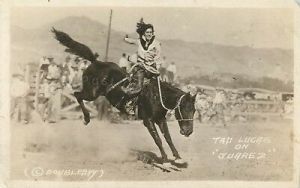
Tad Lucas is a ProRodeo Hall of Fame cowgirl inductee.


